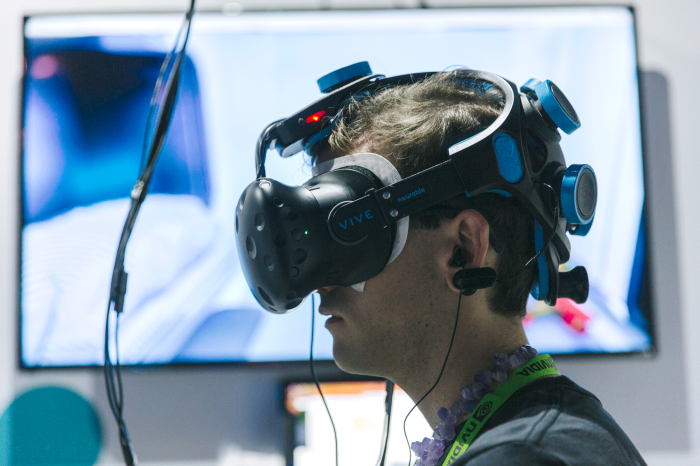Mind-Controlled VR Game Really Works

It may be a while yet before you can harness telekinetic powers in real life, but a brain-controlled virtual-reality game is aiming to let you use your mind to pick up and throw items with ease as soon as next year.
Neurable, a Boston-area startup, has started showing off (and letting people try) a demo of a dystopic sci-fi game called Awakeningthat the company is working on. It works with an electrode-laden headband that connects to an HTC Vive virtual-reality headset. Awakening casts the VR-headset wearer as a child with telekinetic powers who must escape a government lab by using mind power to pick up various toys—a balloon dog, alphabet blocks, rainbow stacking rings—and throw them. The technology behind the game, which Neurable showed me and also demonstrated at the Siggraph conference on computer animation and interactive techniques in Los Angeles last week, uses dry electrodes placed on the scalp and electroencephalography to track brain activity. Software analyzes this signal and figures out what should happen in the game.
Neurable said it is finishing up Awakening this year and hopes that the game and related hardware will be picked up by some VR arcade companies (of which there are a growingnumber) sometime next year.
The demo starts with a calibration process during which I called out toys—train, plane, and so on—and a person wearing the headset and electrodes was able to accurately and quickly select them from the circle of floating objects in front of him in virtual space. (I could see how he was doing on a computer monitor.)
Rob Jacob, a computer science professor at Tufts University who studies brain-computer interfaces, says he’s excited to see this kind of technology inch toward the mainstream, as it’s typically been used by people who are severely disabled, and it tends to be clumsy and slow.
Neurable has made a lot of improvements in a short period of time and claims more are coming soon. The training process, for instance, takes a couple of minutes, but Neurable cofounder and CEO Ramses Alcaide says it used to last 10 minutes. And by September, he adds, the company hopes to ditch this exercise entirely and just let players jump right into the game.
The hardware is still quite clunky, though, and there’s a ways to go before the software is a finished product. Furthermore, Jacob says, brain-interface technology simply doesn’t work with some people. “The brain is just really complicated.”
Keep Reading
Most Popular
Large language models can do jaw-dropping things. But nobody knows exactly why.
And that's a problem. Figuring it out is one of the biggest scientific puzzles of our time and a crucial step towards controlling more powerful future models.
The problem with plug-in hybrids? Their drivers.
Plug-in hybrids are often sold as a transition to EVs, but new data from Europe shows we’re still underestimating the emissions they produce.
How scientists traced a mysterious covid case back to six toilets
When wastewater surveillance turns into a hunt for a single infected individual, the ethics get tricky.
Google DeepMind’s new generative model makes Super Mario–like games from scratch
Genie learns how to control games by watching hours and hours of video. It could help train next-gen robots too.
Stay connected
Get the latest updates from
MIT Technology Review
Discover special offers, top stories, upcoming events, and more.